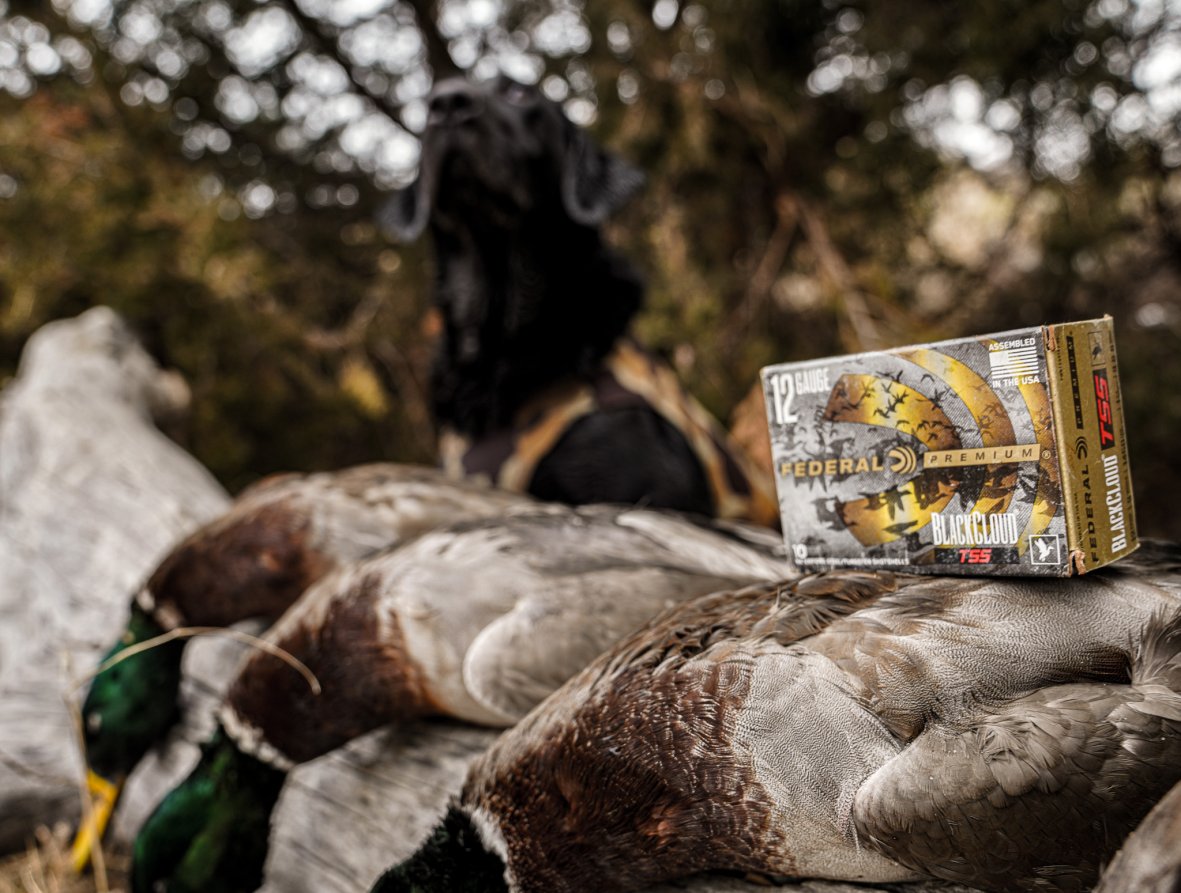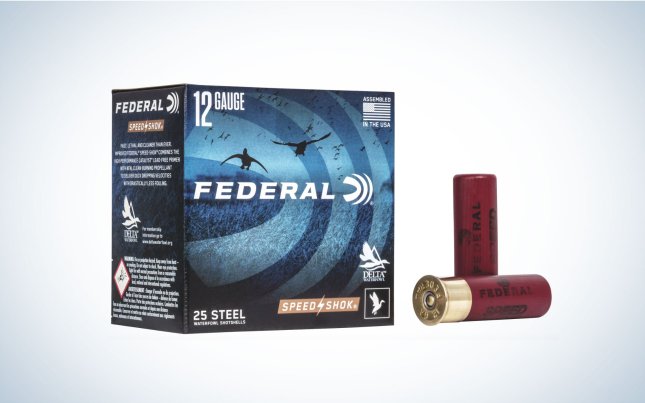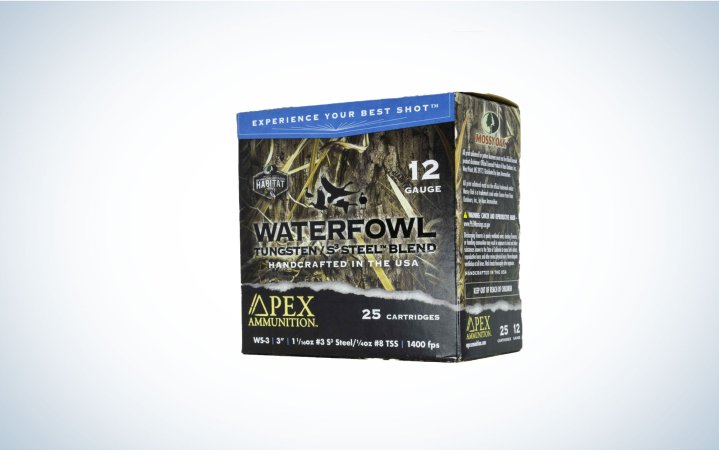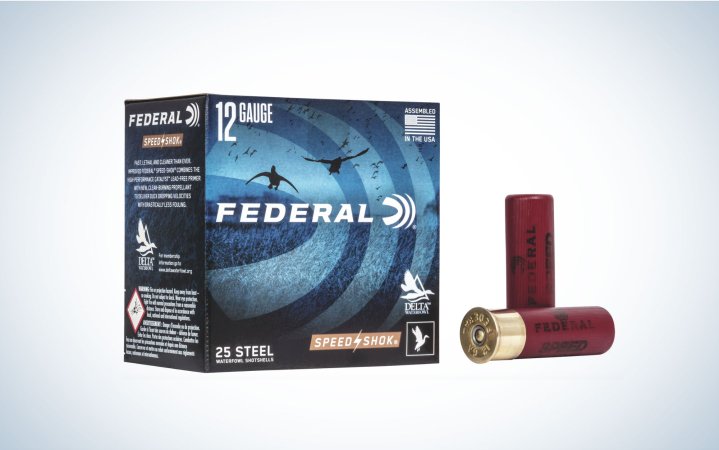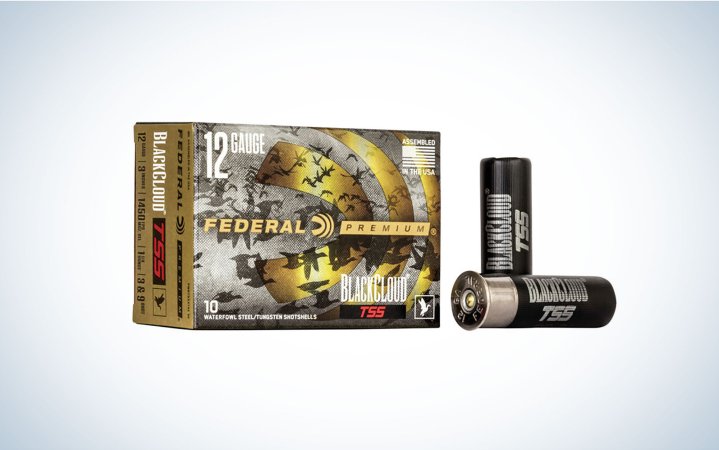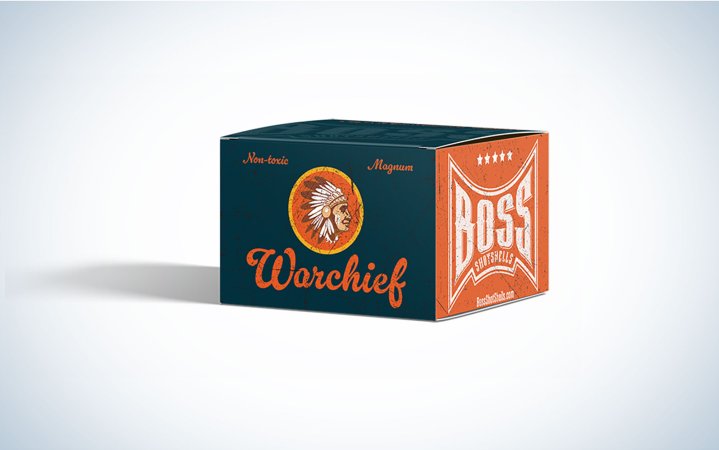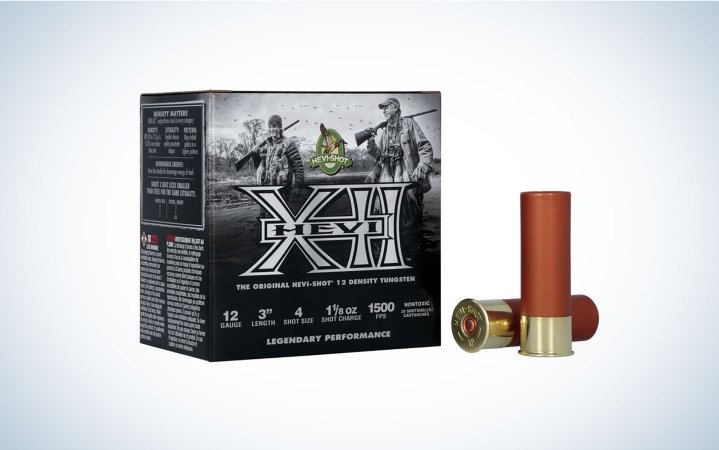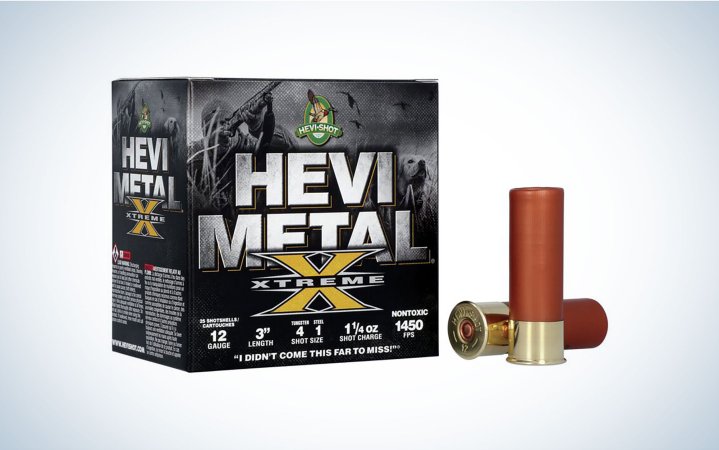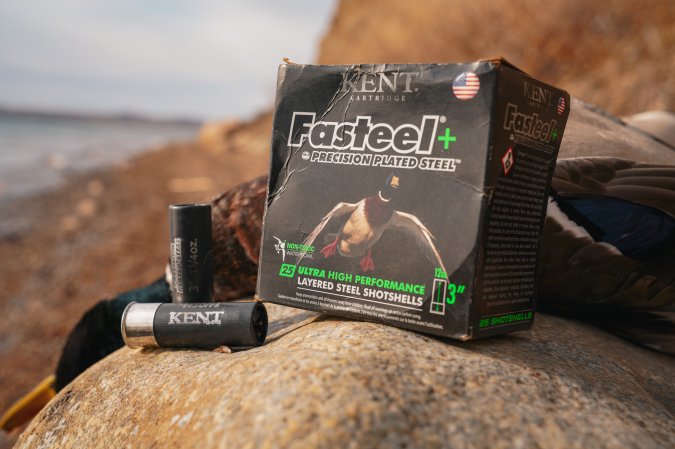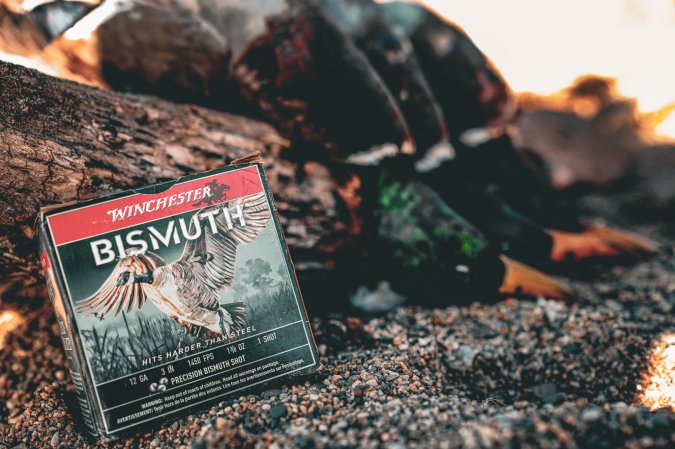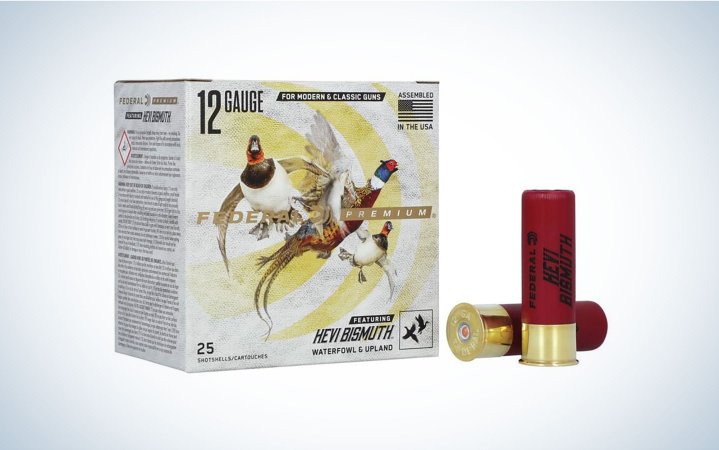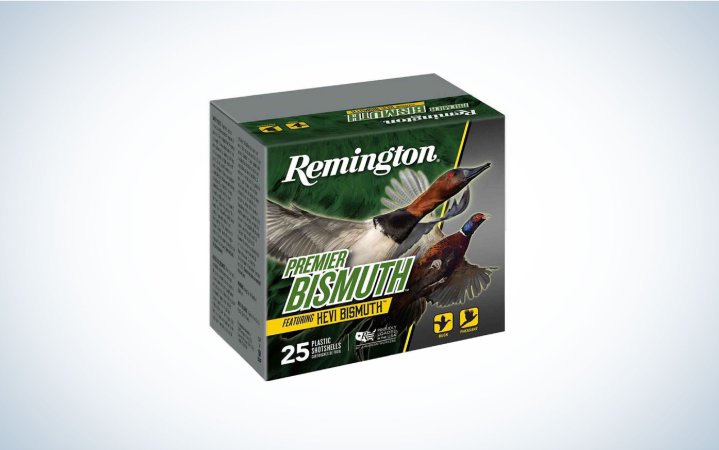We may earn revenue from the products available on this page and participate in affiliate programs. Learn More ›
There are dozens of duck hunting loads on the market today, all with a variety of shot sizes, pellet materials, payloads, velocities, and wad designs. Overwhelmed with options, I think many duck hunters buy their loads in the same way that they might buy a bottle of wine—they walk into a store and go with whatever is on sale or whatever label looks coolest. Or they just go with what they’ve always bought in the past because it has (mostly) worked. But there is a better way to choose the best duck loads.
Ideally, you would want to pattern all of the top loads to see how they perform at the range. You’d also want to hunt with them extensively to see how well they work in a variety of field scenarios. You’d then use a combination of data and anecdotes to solidify your opinions.
If that sounds like a whole lot of trial and error, trigger pulling, pellet counting, and data crunching, well, it is. But don’t worry, I’ve done most of the legwork for you. Below you’ll find my cheat sheet on the best loads for duck hunting.

The Best Duck Loads:
- Best Overall: Apex WS-3
- Best Value: Federal Speed-Shok
- Most Lethal: Federal Blackcloud TSS
- Best Steel Load: Remington Nitro-Steel
- Best Bismuth Load: Boss Warchief
- Best Hevi Shot Load: Hevi XII
- Best Tungsten Value: Hevi Metal Xtreme
Also Worth Considering:
- Kent Fasteel Plus
- Federal Blackcloud
- Winchester Bismuth
- Federal Hevi Bismuth
- Remington Premier Bismuth
How I Chose the Best Duck Loads

There are three key ways to evaluate a duck load: how it performs in the field; how it does on the patterning board; and how much that performance is going to cost you.
Field Performance
Most of the time hitting a duck and killing it cleanly has more to do with your shooting ability than the shells you stuffed in your magazine. However, if you’re an experienced duck hunter and you shoot different loads head-to-head you’ll notice some subtle differences (and some that are not so subtle) in performance. So for my hunts during the last couple seasons I brought along two comparable loads. I would shoot one load for half the hunt and then switch, taking down notes and anecdotes on performance.
After that, I shot totally different loads against each other. For example I’d shoot an affordable steel load on the same hunt as a pricey tungsten load.
To gather even more anecdotes, I gave test loads to trusted buddies while we were hunting out of the same blinds. After a couple seasons and many dead ducks, I’ve developed a 0 to 5 field performance score for each load.
0 = Poor
1 = Fair
2 = Good
3 = Very Good
4 = Excellent
5 = Exceptional

Loads with a “poor” rating did not make the cut for this review. Consider loads with a “fair” rating to be average in terms of what is available on the market. All of the other loads that made the list deliver above-average field performance compared to the entire waterfowl load market.
I’ll admit this scoring system is highly subjective. The rating is based on field anecdotes, not scientific research. But it is my honest assessment after seeing hundreds of ducks get shot with this selection of loads.
Patterning Performance

Patterning data is much more straightforward. I shot all loads at 40 yards, which is not only an industry standard but is what I consider to be the maximum range for consistently killing ducks for most hunters.
I shot four patterns with each load, all through my 12-gauge Benelli SBE 3.
The steel and tungsten loads were shot through a stock Modified choke. The bismuth loads were patterned with an aftermarket Muller H20 Improved Modified choke. Bismuth requires more constriction to pattern well and the Muller proved to be the most consistent choke in my review of the best chokes for duck hunting.
After all the shooting was done, I counted pellet strikes inside a 30-inch circle covering the core of the pattern, as is the industry standard. I then averaged the total number of pellet strikes of the four patterns for each load.
I also evaluated patterns for evenness and consistency. When evaluating a pattern, you want to see the pellet strikes spread evenly throughout the core and then gradually decrease as you move toward the edges. You do not want to see big gaps in the pattern.
It’s important to note that duck loads will pattern differently through different gun/choke combinations. So consider my data to be a guide before doing your own pattering with your own set up.
Price
You could make a good argument that all duck loads are expensive these days. Even the best value load from this test costs almost a dollar per shell. So when selecting the best overall load, I also factored in cost and have listed the cost per sell in each writeup below. That figure is the lowest price that I could find commonly available online.

Pellet Material
There are three common non-toxic materials in duck loads: steel, bismuth, and tungsten. Here’s a breakdown of each.
Steel
Pros: Most affordable; most widely accessible; available in a large variety of shot sizes; gauges, and payloads; patterns tight
Cons: Lowest density (7.8 g/cc); requires larger shot sizes which means fewer pellets per payload
Bismuth
Pros: Denser (9.6 g/cc) than steel; Middle price point; more new options hitting the market
Cons: Prone to fracturing; requires more choke constriction for dense patterns
Tungsten
Pros: TSS is the highest density (18 g/cc), with Hevi-Shot’s tungsten-matrix being the second densest (12 g/cc) pellet material; small shot size allows for many pellets per payload; creates incredibly lethal patterns
Cons: Can be prohibitively expensive
Shot Size Selection
The goal here was not to compare all loads at the same pellet size. Instead, for each load I selected the shot size that I had the most consistent success with. For the standard steel loads, that meant No. 2s (or No. 2 combined with BB in the case of Kent). I’ve found that No. 3 bismuth is a good middle ground for killing ducks, but I went bigger for Remington and Winchester since they don’t make bismuth No. 3s. Contrary to popular opinion, I do not like shooting small bismuth pellets (like No 5s or No 6s) at ducks. Tungsten loads shine with smaller pellet sizes and when combined with large steel pellets.
| Shot Size | Pay Load | Density | $ Per Box | $ Per Shell | Field Perf | 30″ Pattern @40 Yds | |
| Steel | |||||||
| Remington Nitro Steel | No. 2 | 1 1/4 | 7.8 g/cc | $35 | $1.40 | 1 | 117 pellets |
| Federal Speed Shok | No. 2 | 1 1/4 | 7.8 g/cc | $22 | $0.88 | 1 | 107 pellets |
| Kent Faststeel 2.0+ | No. 2 | 1 1/4 | 7.8 g/cc | $27 | $1.08 | 1 | 91 pellets |
| Federal Black Cloud | No. 2 | 1 1/4 | 7.8 g/cc | $43 | $1.60 | 1 | 104 pellets |
| Bismuth | |||||||
| Boss War Chief | No. 3 & No 5 | 1 1/2 | 9.6 g/cc | $45 (20) | $2.25 | 3 | 160 pellets |
| Federal Hevi Bismuth | No. 3 | 1 3/8 | 9.6 g/cc | $60 | $2.40 | 2 | 85 pellets |
| Remington Premier Bismuth | No. 2 | 1 3/8 | 9.6 g/cc | $71 | $2.84 | 2 | 75 pellets |
| Winchester Bismuth | No. 1 | 1 3/8 | 9.6 g/cc | $58 | $2.32 | 2 | 91 pellets |
| Tungsten | |||||||
| Apex WS 3 | No. 3 & No. 8 | 1 1/4 | 18 g/cc | $55 | $2.20 | 4 | 168 pellets |
| Federal Blackcloud TSS | No. 3 & No. 9 | 1 1/4 | 18 g/cc | $49 (10) | $4.90 | 5 | 223 pellets |
| Hevi Shot Hevi XII | No. 4 | 1 1/8 | 12 g/cc | $84 | $3.36 | 4 | 111 pellets |
| Hevi Metal Xtreme | No. 1 & No. 4 | 1 1/4 | 12 g/cc | $49 | $1.96 | 3 | 103 pellets |
The Best Duck Loads: Reviews & Recommendations
Best Overall: Apex WS-3
Pros
- Kills ducks cleanly all reasonable ranges
- Excellent performance-to-price ratio
Cons
- Still a bit pricey for the average duck hunter
- Limited availability
Key Features
- Field performance: 4
- Average 40-yard Pattern: 168
- Price per shell: $2.20
- Shot size: No. 3 steel & 8 TSS
- Payload: 1 1/16 ounce steel & ¼ ounce TSS
- Velocity: 1400 fps

I think the best way to sing the praises of Apex’s WS-3 is to tell you that I keep a few of these loads in my blind bag at all times, just in case I find myself in a little shooting slump. If I happen to miss a couple ducks, I’ll throw these loads in and, almost without fail, birds begin to fall. I’ll acknowledge that part of this is psychological. Confidence is key to good shooting. But check out the pattern that the Apex WS-3 load throws and you’ll see why I feel so confident while shooting them.
Apex mixes its own No. 3 steel pellets with a quarter ounce of No. 8 TSS pellets. While in flight, those little number 8s fill in the gaps between the larger steel pellets and make phenomenal patterns. Of course you still have to put this pattern on the bird, but when you do, it will fall dead.
I’ve had wonderful success hunting with these loads out of a standard Modified choke. You could choke this load tighter but then you would blow ducks to smithereens at close ranges. Because it holds such a dense pattern at distance with a Modified choke, I think it’s the ultimate option for shooting ducks at 25 to 50 yards.
Could you kill ducks beyond that range with this load? Almost certainly. But why would you want to?

As for price, it falls right in the middle. It’s more expensive than the steel loads, but it’s actually cheaper than all of the bismuth loads in this review. If you are looking to step up in performance (and price) beyond standard steel loads, I recommend going with Apex WS-3, assuming you can find them available—they have a tendency to go out of stock.
Best Value: Federal Speed-Shok
Pros
- Good pattern performance at 40 yards
- Affordable
Cons
- Average steel performance
Key Features
- Field performance: 1
- Average 40-yard Pattern: 107
- Price per shell: $0.88
- Shot size: No. 2 Steel
- Payload: 1 ¼ ounces
- Velocity: 1450 fps
In the excitement (dare I say, hype?) over bismuth and TSS loads, steel often gets a bad rap. But when you can find a 3-inch steel load that patterns nicely with No. 2 shot in a Modified choke, well, you’ll have no problem killing ducks out to 40 yards with competent shooting. And that’s exactly what Federal’s Speed-Shok load delivers. It printed denser patterns than other steel loads I tested (except for Remington’s Nitro Steel) and even outperformed the much more expensive Federal Blackcloud steel load.
Shotshell expert Tom Roster has done extensive testing on steel shot lethality. Through research, he’s found that a pattern density of about 90 steel No. 2 pellets inside a 30-inch circle is required to kill large ducks at distance. With that in mind, this Speed-Shok load in my setup will be a duck slayer at 40 yards and in all day long.
Most Lethal: Federal Blackcloud TSS
Pros
- Incredible patterns at long range
- Majority of payload consists of TSS
Cons
- Too expensive for most hunters
- Not ideal for shooting close decoying ducks
Key Features
- Field performance: 5
- Average 40-yard Pattern: 223
- Price per shell: $4.90
- Shot size: No. 3 Steel and No. 9 TSS
- Payload: 1 ¼ ounces
- Velocity: 1450 fps
If ducks were dangerous game and you had but three shells to stop a charging greenhead before he gored you with his sharp little toenails and pummeled you to death with his banana-yellow bill, then you, my friend, would want to be loaded up with Federal’s Blackcloud TSS.
Like the Apex load, this Federal load combines large steel shot with tiny TSS shot. Unlike the Apex load, the majority of the Federal payload is made up of TSS. In fact, 60 percent of the payload is No. 9 TSS.
All packed into a Flitecontrol Flex wad, this is kind of like a turkey load with a bunch of No. 3 steel shot mixed in (280 pellets in total). The result is absolutely devastating patterns. As you can see in the photo below, the Federal Blackcloud TSS load was delivering twice as many pellet strikes as the steel loads in this test. It printed far denser loads than the Apex WS-3 as well.
In my patterning work, it seemed that the TSS would fill up the core of the pattern while the larger steel shot would mostly strike around the edges. In theory, this probably helps with lethality. The dense wall of TSS pellets are ideal for head and neck strikes, with larger pellets around the edges being better for body hits.

If you are skeptical about the killing power of those little No. 9 TSS pellets, let me tell you a quick hunting story. When the load was first introduced, a buddy and I split a box of them and then kicked open a little hole in the ice of a cattail slough one chilly North Dakota morning. It wasn’t long before a big flock of gadwall was circling our spread. As they closed to about 30 yards, all balled up tight, my buddy and I each shot one shell, simultaneously. Six ducks fell from the center of the flock. Five were stone dead with only one requiring a follow-up shot. We looked at each other, bewildered.
But this sort of performance is actually one of the load’s downsides. It’s too much payload—overkill in the truest sense—for shooting close-range ducks. The other downside is the price. The best deal I was able to find on it was $49 for a box of ten.
I did not pattern this load beyond 40 yards because I did want to encourage bad behavior. But if you are determined to shoot ducks at long range, put the time in to become a truly skilled wingshot, and shoot a load like this one.
Best Steel Load: Remington Nitro-Steel
Pros
- Densest steel patterns
- Good pattern density from lighter payload
Cons
- Pricier than other basic steel loads
Key Features
- Field performance: 1
- Average 40-yard Pattern: 117
- Price per shell: $1.40
- Shot size: No. 2 Steel
- Payload: 1 ¼ ounces
- Velocity: 1450 fps

As a bit of a dark horse, good old Remington Nitro-Steel handily won the steel division of the patterning test. As veteran hunters and shooters know, Remington ammo has had quality issues and supply problems in the past. But since Remington ammo was bought by Federal’s parent company (now called The Kinetic Group) Big Green has been on a comeback. In 2021 I visited the ammo plant in Lonoke, Arkansas, and I’ve seen first hand how they’ve put more work into quality control. That effort is reflected in the ammo, including in the performance of Nitro-Steel.
Despite the name, this is not a souped up scorching fast load (that would be Remington Hypersonic, which I had trouble getting to pattern well). Nitro steel is a well balanced load at 1450 fps with a 1 ¼ ounce payload. That resulted in great patterns at 40 yards. In my review of the best chokes for duck hunting, I was able to get these loads to pattern even better with the Mojo Fatal Shot choke. If you’re a fan of high pattern percentages, you will appreciate Nitro-Steel. If you’re having trouble getting these loads to pattern as well as they did in my gun, you can try stepping down in velocity to 1300 fps.
Best Bismuth Load: Boss Warchief
Pros
- Densest bismuth patterns
- Most affordable bismuth load
Cons
- More expensive than previous Boss loads (now sold in box of 20)
Key Features
- Field performance: 3
- Average 40-yard Pattern: 160
- Price per shell: $2.25
- Shot size: No. 3 and 5 stacked copper-plated bismuth
- Payload: 1 ½ ounces
- Velocity: 1350 fps
Boss should be given a lot of the credit for the resurgence of bismuth shot. The direct-to-consumer company took the waterfowl world by storm in 2018 with smart marketing and shells that delivered in the field and on the patterning board. Introduced late in 2023, the new Boss Warchief loads have some upgrades from the legacy shells. First, the shot is buffered with a fine biodegradable material, which Boss says is proprietary. With a soft or brittle pellet material (like bismuth) buffering is designed to prevent pellet deformation or fracturing at ignition and should lead to better patterns and downrange performance.
Second, Boss upgraded the wad so it now runs the full length of the shell and holds the entire payload. Interestingly, Boss says the new wad is infused with an additive that helps it decompose after it’s fired (so it won’t sit in the bottom of a marsh for the next one hundred years).
The No. 3 and 5 Warchief loads printed truly impressive patterns at the range. In fact, they’re the best patterns I’ve seen in a bismuth duck load. As you can see in the photo, they formed an even and dense spread of pellet strikes with no big holes or gaps in the core. My best pattern put 166 pellets inside a 30-inch circle. With about 215 total pellets in the load, that’s an approximately 77 percent pattern percentage—if you care about that sort of thing. Remember that was achieved with an Improved Modified Muller H20 choke. A Full choke certainly would have upped that percentage, but it also would have created too tight of a pattern for close-range ducks, at least for my liking. For hunting at reasonable ranges I wouldn’t choke Warchief tighter than IM in my gun.

Some diehard Boss fans will tell you that the 2 ¾ inch “shorty” shells loaded with No. 5 shot are all you’ll ever need. But I’ve had much better success hunting with Boss’ magnum 3-inch No. 3 and 5 stacked load, which have a 1 ½ ounce payload.
Sadly, I didn’t get my hands on the new 12-gauge Warchiefs in time for duck season. I did however get to watch some buddies absolutely hammer late-season mallards with the 28-gauge version of the Warchief loads. That impressive performance on the water plus the killer data on the patterning board proves that Boss is still the king of bismuth.
Best Hevi Shot Load: Hevi XII
Pros
- Dense pellets at 12 g/cc
- Excellent combination of pellet density and pattern density
- Good long-range load
Cons
- Very expensive
Key Features
- Field performance: 4
- Average 40-yard Pattern: 111
- Price per shell: $3.36
- Shot size: 4 Hevi Shot
- Payload: 1 1/8 ounces
- Velocity: 1500 fps
Veteran duck hunters know that Hevi Shot is the real deal. And though the company now has a wide variety of offerings, their best performing duck load is Hevi XII, which has a payload consisting of the original 12 g/cc pellets made of the company’s proprietary tungsten matrix material.

On the patterning board these loads might not look all that impressive when compared to steel. For example, the top steel loads put more No. 2 pellets on target than Hevi XII did with No. 4 pellets. What gives? This is largely because those Hevi XII pellets weigh so much that it doesn’t take as many of them to make up a 1 1/8 ounce payload (approximately 142 of them). For larger payloads step up to the 1 ¼ ounce versions of the shell.
It’s in the field where Hevi XII really shines. Folks who have shot it extensively know that the load efficiently kills ducks and geese at ranges near and far. There are only two downsides to Hevi XII. First, it’s expensive (behind only the Federal TSS load in price). Second, the pellets in this load are misshapen. Cut a shell open (if your wallet can withstand the hit) and you’ll find not perfectly uniform spheres, but globs and blobs and pellets of slightly different sizes, with some stuck together looking like tiny tungsten snowmen. This doesn’t seem to hurt field performance (I cannot reiterate enough, these loads straight up crush ducks) but in theory it would hurt pattern performance as misshapen pellets often become flyers.
Best Tungsten Value: Hevi Shot Xtreme
Pros
- Dense No. 4 Hevi Shot pellets (12 g/cc)
- Large No. 1 steel pellets
- Good long-range load
Cons
- Does not create very dense patterns
Key Features
- Field performance: 3
- Average 40-yard Pattern: 102
- Price per shell: $1.96
- Shot size: No. 1 Steel and No. 4 Hevi Shot
- Payload: 1 1/4 ounces
- Velocity: 1450 fps
If you want to shoot Hevi Shot without paying the full Hevi Shot price, then the new Xtreme load (introduced late in 2023) is for you. The payload consists of 30 percent Hevi Shot at 12 g/cc and 70 percent steel. Similar to the Apex loads, this allows you to take advantage of denser materials without having to spend $5 per shell (or more) for a full payload of tungsten. It’s important to note that Hevi Shot lists this load at $60 per box of 25, but if you shop around online you’ll find it for $49 per box easily enough. At that price, it’s a great deal. It’s cheaper than all the bismuth loads and in my opinion delivers as good or better field performance.
The round is available in several combinations of pellet sizes: 3 steel / 6 Hevi Shot; 1 steel / 4 Hevi Shot; and BB steel / 2 Hevi Shot. I found that the No. 1 steel / 4 Hevi Shot combination kills ducks the deadest. Hunting buddies and I did not have good success with the 3/6 combination.

At first glance the patterns from this load might not wow you. But remember all those strikes are from big No. 1 steel pellets or very dense No. 4 Hevi Shot pellets. If you did a little experimenting with Xtreme to find its optimum choke constriction in your gun, you’d certainly have a capable load at 40 to 50 yards. I found it to be quite effective on longer shots at passing wood ducks earlier this season.
Other Duck Loads Worth Considering
Kent Fasteel Plus
Pros
- Puts big pellets on target
- Good mid-range load
Cons
- Somewhat sporadic results on the patterning board
Key Features
- Field performance: 1
- Average 40-yard Pattern: 91
- Price per shell: $1.08
- Shot size: No. 2 Steel and BB Steel
- Payload: 1 1/4 ounces
- Velocity: 1450 fps
This new load is a good choice for hunters who can’t quite decide if they want to shoot No. 2 or BB—the Kent payload is packed with both. While the average pattern density for this load was good, considering the large pellet size, I did have some anomalous results. I shot one pattern of only 50 strikes and another of 110. I’ll have to do more testing with this load in the future.
Federal Blackcloud FS
Pros
- Consistent and reliable
- Great mid-range load
Cons
- Expensive for steel
Key Features
- Field performance: 1
- Average 40-yard Pattern: 103
- Price per shell: $1.60
- Shot size: No. 2 Steel
- Payload: 1 1/4 ounces
- Velocity: 1450 fps
For a long time Blackcloud was considered a premium duck load at a premium price. Federal’s Flitecontrol Flex wad premiered in Blackcloud and is designed with a braking system to separate from the payload at a precise distance from the muzzlel. This wad works with all duck hunting chokes, even those with a wad stripper design. Another interesting feature is that 40 percent of the payload consists of Flitestopper pellets which have a cutting ring (imagine a little hula hoop of destruction molded around the pellet) designed to create better wound channels. These Blackcloud loads still work just as well as they ever did, but now there is more effective (and yes, expensive) pellet material widely available on the market.
Winchester Bismuth
Pros
- Big bismuth pellets
- Great patterns
- Good choice for big ducks and geese
Cons
- Expensive
- Limited availability
Key Features
- Field performance: 2
- Average 40-yard Pattern: 91
- Price per shell: $2.32
- Shot size: No. 1 bismuth
- Payload: 1 3/8 ounces
- Velocity: 1450 fps
Winchester introduced its bismuth load in 2022 and has been impressing duck hunters and gun writers since. You can find our full review on Winchester bismuth here. The load has a polymer buffer, which looks like a pile of tiny plastic pellets mixed in with the shot. Like the buffering in the Boss shells, it’s designed to prevent shot deformation and fracturing. The bismuth shot is tin-plated and consistently formed, unlike some other bismuth loads on the market. It’s made in No. 4 and No. 1 shot size options, but during duck season I wasn’t able to track down any No. 4s. This didn’t break my heart since I prefer larger bismuth shot sizes anyway. The No. 1s performed admirably on late-season greenheads and divers. I think this would be an ideal choice for duck and goose combination hunts.
Federal Hevi Bismuth
Pros
- Ideal bismuth pellet size for ducks
- Versatile load
Cons
- Expensive
- Poor patterns with open chokes
Key Features
- Field performance: 2
- Average 40-yard Pattern: 85
- Price per shell: $2.40
- Shot size: No. 3 bismuth
- Payload: 1 3/8 ounces
- Velocity: 1450 fps
I’ve hunted extensively with Federal’s Hevi Bismuth load since it was introduced in 2022. The load uses Hevi Shot’s bismuth pellet combined with Federal’s Flitecontrol wad. Here’s the skinny on this load’s performance: It works great with tighter chokes; I did notice some fracturing while patterning; it does not work well with open chokes. You can read my full review on Federal Hevi Bismuth here. For that range test I shot the load through a stock Full choke and recorded impressively dense patterns (128 pellet strikes in a 30-inch circle for 76 percent pattern percentage). So if you want to shoot this load at longer ranges, try patterning it with a full choke first.
Remington Premier Bismuth
Pros
- Large bismuth pellets for big ducks and geese
- Available in 12, 20, 28 gauges, and .410 bore
Cons
- Priciest bismuth load
Key Features
- Field performance: 2
- Average 40-yard Pattern: 75
- Price per shell: $2.84
- Shot size: No. 3 bismuth
- Payload: 1 3/8 ounces
- Velocity: 1450 fps
Remington’s Premier ammo line captures all of Big Green’s best and most technologically advanced loads. Premier Bismuth, like Federal’s Hevi Bismuth, is loaded with Hevi Shot’s bismuth pellets. It’s available in No. 5 and No. 2 shot. I consider the 5s to be good upland loads and the 2s to be the better choice for waterfowl hunting. Federal doesn’t load a No. 2 bismuth pellet (neither does Winchester), so this is a good option if neither No. 1 or No. 3 pellets are your cup of tea. This load did fine on the patterning board but didn’t knock my socks off. In future testing I’ll be curious to see how this load performs through a full choke.
Read Next: Best Duck Hunting Shotguns
FAQs
Assuming we’re talking about steel, go with No. 2 shot for most duck hunting scenarios. If you’re hunting early-season teal, No. 4 steel shot is a fine choice. With denser Hevi Shot XII, I prefer No. 4s for more pellets on target. With bismuth, go with No. 3 shot for most duck hunting scenarios.
This all depends on your payload and pellet material. Here’s a general breakdown of approximate pellet counts:
Steel No. 2, 1¼ ounce payload: 156 pellets
Steel No. 2, 1 ⅜ ounce payload: 172 pellets
Bismuth No. 3, 1 ⅜ ounce payload: 168 pellets
Hevi Shot No. 4, 1 1/8 ounce payload: 142 pellets
My pick for the best wood duck load would be Boss Warchief No. 3/5s. Wood ducks aren’t very big or tough to bring down so a good patterning steel No. 3 load would work fine as well.
Happily almost all of the loads in this review are offered in 20 gauge options. Because payloads in 20-gauge offerings are often smaller, I’d go with the Apex WS-3, the Hevi Shot XII, or Warchief No. 3/5. If you’re going to limit yourself to fewer pellets, you should make sure those pellets are dense and deadly.

Final Thoughts on the Best Duck Loads
Almost any duck load will work when choked properly and paired with good shooting. But the best duck loads listed here bring above-average performance, above-average value, or both. And while this test is extensive, it’s far from complete. Next year there will be more new loads to test (and some old ones to retest) and more ducks to shoot. I’ll continue adding to this review as I get more data from the range and anecdotes from the field. I hope you take a similar approach when doing your own hunting and patterning.
- Best Overall: Apex WS-3
- Best Value: Federal Speed-Shok
- Most Lethal: Federal Blackcloud TSS
- Best Steel Load: Remington Nitro-Steel
- Best Bismuth Load: Boss Warchief
- Best Hevi Shot Load: Hevi XII
- Best Tungsten Value: Hevi Metal Xtreme
